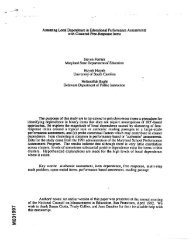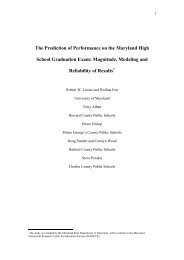A Brief Introduction to Evidence-Centered Design CSE Report 632 ...
A Brief Introduction to Evidence-Centered Design CSE Report 632 ...
A Brief Introduction to Evidence-Centered Design CSE Report 632 ...
You also want an ePaper? Increase the reach of your titles
YUMPU automatically turns print PDFs into web optimized ePapers that Google loves.
concerns administering pre-assembled test booklets <strong>to</strong> examinees and collectingtheir bubbled-in answer sheets. In the CAT, presentation concerns presenting acus<strong>to</strong>mized sequence of items <strong>to</strong> an examinee one at a time, in each instancecapturing a response <strong>to</strong> be evaluated on the spot that will guide the selection of thenext item. In an operational DISC assessment, presentation could be based o npredetermined suites of cases or cases selected at random from a pool, subject <strong>to</strong>coverage constraints.How Is <strong>Evidence</strong> Extracted From a Task Performance: Response ProcessingResponse Processing is responsible for identifying the key features of the workproduct which are the observable outcomes for one particular task. The observableoutcomes can either go back <strong>to</strong> the participant for task level feedback or on <strong>to</strong> thesummary scoring process. Examples include matching a selected response <strong>to</strong> ananswer key, running an essay through an au<strong>to</strong>mated scoring engine, and having ahuman rater score a student portfolio according <strong>to</strong> a rubric. The evidence rules fromthe CAF specify how this is <strong>to</strong> be accomplished. Response processing can consist ofmultiple stages, as when lexical and syntactic features are identified in an essay and aregression model is used <strong>to</strong> summarize them in<strong>to</strong> a single score for a response <strong>to</strong>this task.The logical content of response processing is the same in GRE CAT and P&Pforms: The student’s answer is compared with the key. The implementation israther different for the two modes of administration, however. In the P&P version,sophisticated algorithms and sensitive machines are employed <strong>to</strong> determine, viarelative intensities of light reflection, which answer bubble the student marked. Inthe CAT version, the character that corresponds <strong>to</strong> the location where the studentclicked a mouse but<strong>to</strong>n <strong>to</strong> indicate an answer choice is compared with the characters<strong>to</strong>red in memory as the key.Response processing in an operational DISC assessment would consist ofrunning au<strong>to</strong>mated rules on the sequence of actions a student carried out in order <strong>to</strong>identify and summarize salient features, as required, for example, <strong>to</strong> determinewhether the student had addressed the patient's chief complaint. The students'filled in evaluation forms of their simulation patients would also be evaluated fornot only correctness, but also efficiency and internal consistency.15






